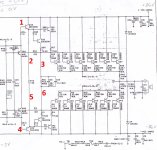1. 0.67V
4. 1.3V
2. 0.06V
5. 0.7V
3.
6.
I have a bit of difficulties to measure the last points because the OL-2 board is not connected and the amp turns itself off. I have put the diodes to the cable which goes to the OL-2 board. I had this similar behavior before. Do you know why it happens?
4. 1.3V
2. 0.06V
5. 0.7V
3.
6.
I have a bit of difficulties to measure the last points because the OL-2 board is not connected and the amp turns itself off. I have put the diodes to the cable which goes to the OL-2 board. I had this similar behavior before. Do you know why it happens?
For your info, I will be away from home the whole weekend and I cannot do any measurements before monday, but thank you again so far.
It seems that all predrivers are ok and so are the 8 end stage transistors.
So
That’s very strange.
When you remove the 4 diodes, the voltages drop over the 100R resistors are becoming almost 85 Volt, true ?
But what is at that moment the voltage between the two WHs
Hans
So
you have disconnected the OL2 board, but the amp switches off ?1. 0.67V
4. 1.3V
2. 0.06V
5. 0.7V
3.
6.
I have a bit of difficulties to measure the last points because the OL-2 board is not connected and the amp turns itself off. I have put the diodes to the cable which goes to the OL-2 board. I had this similar behavior before. Do you know why it happens?
That’s very strange.
When you remove the 4 diodes, the voltages drop over the 100R resistors are becoming almost 85 Volt, true ?
But what is at that moment the voltage between the two WHs
Hans
But this is even more strange; I took the diodes off and powered the amp and there is only 1.3V over the resistors! 2V was between the WHs. Even with the OL-2 board connected. I was also able to do the biasing by turning the pot and voltage over the 100R resistors starts to increase.
Somehow without notice I have repaired the amp. I remember that in some point I scraped beween the TO-220 transistors soldering pads to make sure that there is no shorts. Maybe that was the reason, who knows.
But this leaves the sitation a bit open because no clear explanation...
Somehow without notice I have repaired the amp. I remember that in some point I scraped beween the TO-220 transistors soldering pads to make sure that there is no shorts. Maybe that was the reason, who knows.
But this leaves the sitation a bit open because no clear explanation...
It may be that a short called solder whisker was causing the trouble, a growing piece of solder going from one trace to another because of a large voltage difference.But this is even more strange; I took the diodes off and powered the amp and there is only 1.3V over the resistors! 2V was between the WHs. Even with the OL-2 board connected. I was also able to do the biasing by turning the pot and voltage over the 100R resistors starts to increase.
Somehow without notice I have repaired the amp. I remember that in some point I scraped beween the TO-220 transistors soldering pads to make sure that there is no shorts. Maybe that was the reason, who knows.
But this leaves the sitation a bit open because no clear explanation...
So we solved a problem that hopefully doesn’t come back, altough it can also be a bad solder joint or a crack in a trace.
These are both very temp dependent so it’s a good idea to let the amp warm up over a longer period.
Hans
I am also planning to install the remaining 4 output transistors. It might be good idea to install only one or two at a time and measure between that they are ok?
I am in the process of recapping my ML No.23 amp and came across this resistor which looks damaged. Can anyone tell me what the value should be? It is on the front board behind the face plate.

I just purchased this amp second hand. Obviously someone was in there before. I suspect something happened on this board that was repaired. I don't know why the LED was replaced, but I will remove that abomination and replace it with a correctly mounted LED. The resistor I need the value for has a crack so I will replace it. After cutting one end I measured 30 ohms but am not confident it is correct.
- Home
- Amplifiers
- Solid State
- Mark Levinson No23 repair help
